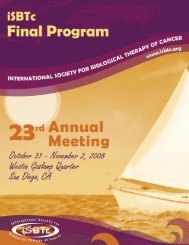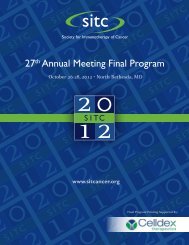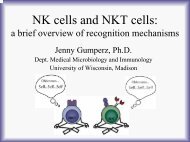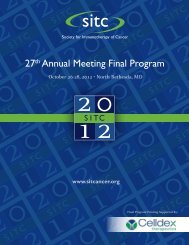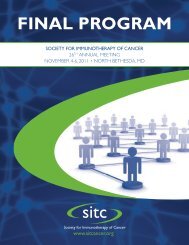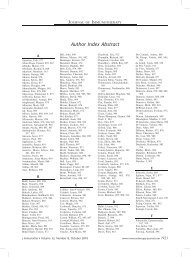Abstracts for the 25th Annual Scientific Meeting of the International ...
Abstracts for the 25th Annual Scientific Meeting of the International ...
Abstracts for the 25th Annual Scientific Meeting of the International ...
Create successful ePaper yourself
Turn your PDF publications into a flip-book with our unique Google optimized e-Paper software.
<strong>Abstracts</strong> J Immuno<strong>the</strong>r Volume 33, Number 8, October 2010<br />
knockdown <strong>of</strong> <strong>the</strong> genes dramatically decreased <strong>the</strong> tumorigenic<br />
capacity, indicating that <strong>the</strong> genes could be associated with tumorinitiating<br />
capacity <strong>of</strong> CSCs. We could induce cytotoxic T cells<br />
(CTLs) from peripheral blood lymphocytes <strong>of</strong> cancer patients after<br />
in vitro stimulation with SOX2-derived peptides. SP cells were<br />
susceptible to cytotoxicity <strong>of</strong> CTLs, whereas <strong>the</strong>y were resistant to<br />
chemo<strong>the</strong>rapeutic drugs. In addition, DNA vaccine encoding <strong>the</strong><br />
CSC gene showed higher tumor suppressive capacity in vivo in a<br />
mouse tumor model. Our studies indicate that cancer vaccine<br />
targeting CSCs might serve as potent immuno<strong>the</strong>rapy <strong>for</strong> cancer.<br />
Evaluation <strong>of</strong> FOXP3 Microsatellite Polymorphisms in<br />
High-Risk Melanoma Patients Receiving Adjuvant Interferon<br />
Ena Wang*, Helen Gogasw, Alessandro Monaco*, Lorenzo<br />
Uccellini*, Charalampos S. Floudasw, Yanis Metaxasw, Urania<br />
Dafniw, George Fountzilasw, Maria Spyropoulou-Vlachouw,<br />
Francesco M. Marincola*. *Department <strong>of</strong> Transfusion Medicine,<br />
National Institutes <strong>of</strong> Health, Be<strong>the</strong>sda, MD; w Hellenic Cooperative<br />
Oncology Group, A<strong>the</strong>ns, Greece.<br />
Background: Attempts to identify patients who benefit from<br />
adjuvant treatment with interferon alfa-2b (IFN) have been<br />
disappointing. The development <strong>of</strong> autoimmunity during adjuvant<br />
<strong>the</strong>rapy with IFN cannot assist selection <strong>of</strong> patients <strong>for</strong> <strong>the</strong>rapy at<br />
baseline. The FOXP3 is located at Xp11.23 within an area <strong>of</strong><br />
autoimmune disease linkage and <strong>the</strong>re<strong>for</strong>e is an excellent positional<br />
candidate gene <strong>for</strong> autoimmunity at this locus. Consequently we<br />
per<strong>for</strong>med a microsatellite analysis <strong>of</strong> FOXP3 gene in <strong>the</strong> exon 0<br />
region in high-risk melanoma patients enrolled in a study <strong>of</strong> two<br />
regimens <strong>of</strong> high-dose IFN.<br />
Methods: A fragment analysis was per<strong>for</strong>med in <strong>the</strong> DNA <strong>of</strong> 259<br />
stage IIb, IIc and III melanoma patients. After amplification and<br />
electrophoresis run, data from each sample were analyzed using<br />
Genemapper s<strong>of</strong>tware (Applied Biosystems) which objectively calls<br />
<strong>the</strong> fragments size.<br />
Results: Thirteen alleles were detected (size: 284, 286, 288, 290, 292,<br />
298, 302, 304, 306, 310, 312, 314, 316). The tabular distribution <strong>of</strong><br />
<strong>the</strong>se alleles in melanoma patients is presented below (Table 1). At<br />
a median follow up <strong>of</strong> 71 months (range 7.1 to 138.7 mo), 144<br />
patients have recurred and 95 have died. There were no statistically<br />
significant differences in <strong>the</strong> incidence <strong>of</strong> FOXP3 alleles between<br />
melanoma patients who recurred and those with no evidence <strong>of</strong><br />
recurrence. RFS did not differ significantly between patients with<br />
recurrence and those without <strong>for</strong> each <strong>of</strong> <strong>the</strong> alleles detected.<br />
Conclusions: No allele defined by <strong>the</strong> microsatellite analysis <strong>of</strong> <strong>the</strong><br />
FOXP3 gene in exon 0 was correlated with improved RFS in this<br />
high-risk group <strong>of</strong> melanoma patients.<br />
Reshaping CD4 and CD8 Memory T Cell Proliferation by<br />
Treating Cancer Patients with an OX40 Agonist: Immunologic<br />
Assessment <strong>of</strong> a Phase I Clinical Trial<br />
Magdalena Kovacsovics-Bankowski, Edwin Walker, Lana<br />
Chisholm, Kevin Floyd, Walter Urba, Brendan Curti, Andrew<br />
Weinberg. Robert W. Franz Cancer Research Center, Earle A.<br />
Chiles Research Institute, Portland, OR.<br />
OX40, a member <strong>of</strong> <strong>the</strong> TNF superfamily, is a potent costimulatory<br />
molecule expressed upon activation at <strong>the</strong> surface <strong>of</strong><br />
CD4 and CD8 T cells. Its engagement improves T cell effector<br />
function and survival. Preclinical studies have shown that OX40<br />
agonists injected into tumor-bearing mice increase anti-tumor<br />
immunity leading tumor-free survival in several mouse models.<br />
These results prompted <strong>the</strong> initiation <strong>of</strong> phase I clinical trial using a<br />
mouse anti-human OX40 agonist antibody in patients diagnosed<br />
with a variety <strong>of</strong> solid malignancies. In this dose-escalation study,<br />
<strong>the</strong> agonist OX40 antibody was administered on Day 1, 3 and 5 at<br />
0.1, 0.4 and 2 mg/kg, respectively. Immune monitoring analysis,<br />
over a 2 month period, was per<strong>for</strong>med on PBL by flow cytometry<br />
directly ex vivo, using a 10-color antibody panel detecting CD3,<br />
CD4, CD8, CD95, CD28, CD25, CD127, CCR7, FoxP3 and<br />
Ki-67. On Day 8-15, we have observed a 2-3-fold increase in <strong>the</strong><br />
proliferating CD4+ CD95+ T cells as detected by increased Ki-67<br />
staining, mostly in <strong>the</strong> FoxP3- population with no significant<br />
increase in CD4+ FoxP3+ T cells proliferation (Treg). The<br />
proportion <strong>of</strong> cycling CD8+ CD95+ T cells peaked later 15-29<br />
days after <strong>the</strong> administration <strong>of</strong> <strong>the</strong> antibody with a 2-4.5-fold<br />
increase <strong>of</strong> cycling cells compared to a group <strong>of</strong> nine controls.<br />
Interestingly, <strong>the</strong> middle dose (0.4 mg/kg) showed <strong>the</strong> greatest<br />
sustained increase in proliferation <strong>for</strong> both <strong>the</strong> CD4 (non-Treg) and<br />
CD8 memory T cell population. Administration <strong>of</strong> anti-OX40<br />
antibody, not only triggered T cell proliferation, but also increased<br />
<strong>the</strong> activation status <strong>of</strong> <strong>the</strong> CD8+ T cells as measured by <strong>the</strong><br />
co-expression <strong>of</strong> CD38 and HLA-DR on <strong>the</strong> cycling cells. Using<br />
<strong>the</strong>se two surface markers, cycling CD8+ T cells were sorted and a<br />
gene array analysis showed increases in mRNA <strong>for</strong> CD86, CTLA-<br />
4, and 4-1BB when compared to <strong>the</strong> non-cycling CD8+ T cells.<br />
Flow cytometry data confirmed that Ki-67+ CD8+ T cells were<br />
enriched <strong>for</strong> <strong>the</strong>se markers. Finally, in 2 out <strong>of</strong> 3 patients, where<br />
autologous tumor was obtained <strong>the</strong> infusion <strong>of</strong> anti-OX40<br />
antibody appeared to increase <strong>the</strong> proportion <strong>of</strong> tumor specific T<br />
cells. PBMC collected pre and post anti-OX40 administration were<br />
co-cultured with melanoma cell lines. CD8 T cells, from PBMC<br />
obtained after anti-OX40 administration showed an increase in<br />
INF-g secretion toward autologous or HLA-matched melanoma<br />
cell lines. These results suggest that administration <strong>of</strong> an anti-OX40<br />
antibody in cancer patients increases tumor-specific CD4+ and<br />
CD8+ T cells by enhancing <strong>the</strong>ir proliferation and <strong>the</strong> production<br />
<strong>of</strong> type I cytokines.<br />
TABLE 1.<br />
Genes<br />
No Relapse,<br />
N = 115 (%)<br />
Relapse,<br />
N = 144 (%)<br />
Allele_284 2 (1.74) 2 (1.39) 1<br />
Allele_286 2 (1.74) 1 (0.69) 0.586<br />
Allele_288 79 (68.70) 90 (62.50) 0.358<br />
Allele_290 4 (3.48) 2 (1.39) 0.411<br />
Allele_292 0 (0.00) 1 (0.69) 1<br />
Allele_298 1 (0.87) 5 (3.47) 0.231<br />
Allele_302 1 (0.87) 3 (2.08) 0.632<br />
Allele_304 1 (0.87) 2 (1.39) 1<br />
Allele_306 6 (5.22) 11 (7.64) 0.463<br />
Allele_310 16 (13.91) 18 (12.50) 0.853<br />
Allele_312 1 (0.87) 5 (3.47) 0.231<br />
Allele_314 2 (1.74) 2 (1.39) 1<br />
Allele_316 0 (0.00) 2 (1.39) 0.504<br />
P<br />
Characterization <strong>of</strong> Antigen Specific T Cell Activation and<br />
Cytokine Expression Induced by Sipuleucel-T<br />
Johnna D. Wesley, Eric Chadwick, Ling-Yu Kuan, Corazon dela<br />
Rosa, Mark Frohlich, David Urdal, Nadeem Sheikh, Nicole M.<br />
Provost. Dendreon, Seattle, WA.<br />
Sipuleucel-T (PROVENGE s ) is an autologous cellular immuno<strong>the</strong>rapy<br />
designed to stimulate an immune response to prostate<br />
cancer. PA2024 [a recombinant human antigen consisting <strong>of</strong><br />
prostatic acid phosphatase (PAP) and granulocyte macrophagecolony<br />
stimulating factor (GM-CSF)] is cultured ex vivo <strong>for</strong> 2 days<br />
with peripheral blood mononuclear cells (PBMCs) isolated from a<br />
standard leukapheresis procedure. Sipuleucel-T obtained at Wks 0,<br />
2, and 4, after which cells are infused back into subjects. This study<br />
examined <strong>the</strong> T cell activation pr<strong>of</strong>ile and cytokine production in<br />
sipuleucel-T from men with asymptomatic or minimally symptomatic<br />
metastatic castrate resistant prostate cancer enrolled in a Phase<br />
3 study (D9902B, IMPACT). PBMCs from each leukapheresis<br />
were incubated with ei<strong>the</strong>r PA2024 or GM-CSF (sargramostim),<br />
912 | www.immuno<strong>the</strong>rapy-journal.com r 2010 Lippincott Williams & Wilkins



